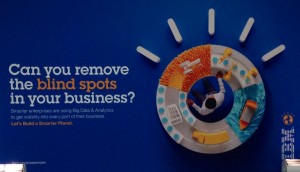 Coming back from a trip to Toronto (visiting with the amazing Min Basadur) I spotted an interesting billboard at O’Hare airport. IBM suggests they can help “Remove the Blind Spots from Your Business” — by using Big Data and analytics. The visual of a man at a kind of virtual desktop that has visibility to ships, trucks, retail, and factories indicates that if you can just know more about what’s going on out there you’ll have nothing to worry about.
Coming back from a trip to Toronto (visiting with the amazing Min Basadur) I spotted an interesting billboard at O’Hare airport. IBM suggests they can help “Remove the Blind Spots from Your Business” — by using Big Data and analytics. The visual of a man at a kind of virtual desktop that has visibility to ships, trucks, retail, and factories indicates that if you can just know more about what’s going on out there you’ll have nothing to worry about.
If only that were so.
I’m not bad rapping IBM here, I’m sure they can indeed provide lots of interesting insight using Big Data and analytics. Many companies would be well served to do a better job with this. Using Big Data (and would someone please define that?) might indeed help you find a blind spot.
However, there are blind spots no amount of data crunching is going to find for you.
The thing that’s going to bite a company in the ass, their true blind spot, are the things that Big Data and analytics can’t tell them smack about. What happens outside the garden wall of the companies industry domain and sphere of influence is trends. Trends that are subtly building in the lives of consumers and in the marketplace. These are the weak signals that hold the promise of new opportunity or sure disaster.
Unless Big Data is doing cultural analysis on a global basis it can’t tell you how, say, the democratization of the market will impact your sales in 2020. Big Data can’t tell you there is a good chance there will be a blight in banana production. It can’t tell you how a collapsing mono-culture in bananas could lead to a dramatic change in many products cost basis, or a shift towards dairy products for breakfast. It wouldn’t have told Levi-Strauss in the early 90’s that prison culture would profoundly impact their bottom line for many years. It wouldn’t have told Sony, who owned mobile music for 30 years, that device superiority wasn’t enough to continue to win.
The very front end of innovation, that messy fuzzy, uncomfortable place is less about analytics and more about Finding New Problems you can transform into opportunities. If you want to make sure you see blind spots before they blind you, you need to regularly be scanning the landscape over your garden wall for things seemingly unrelated to your business in any way. Then ask yourself to Imagine connections. And you can’t do this once a year. You need to do it regularly and with rigour.
Call it Big Imagination.
Best if you couple this mini-process with a structured creative problem solving process like Min Basadur’s Simplexity, or design thinking. Feed that Stage-Gate process with something more interesting than luke-warm insights from expensive qualitative research.
If you don’t have that skill, don’t call IBM, call KILN, they can show you how to keep an eye on the horizon — and not only spot trend data — but actually use it to form Brave New Questions. Is there anything more fascinating but ultimately useless than a massive trend-deck? Making meaning of trends ought to be a whole-brained group exercise. If it isn’t, it’s not likely you’ll arrive at anything but the most obvious insights.
Without Brave New Questions, you won’t have bold new answers, ideas, products or spin-out ventures. Better buy, or build, a better blind spot remover — Big Imagination.


